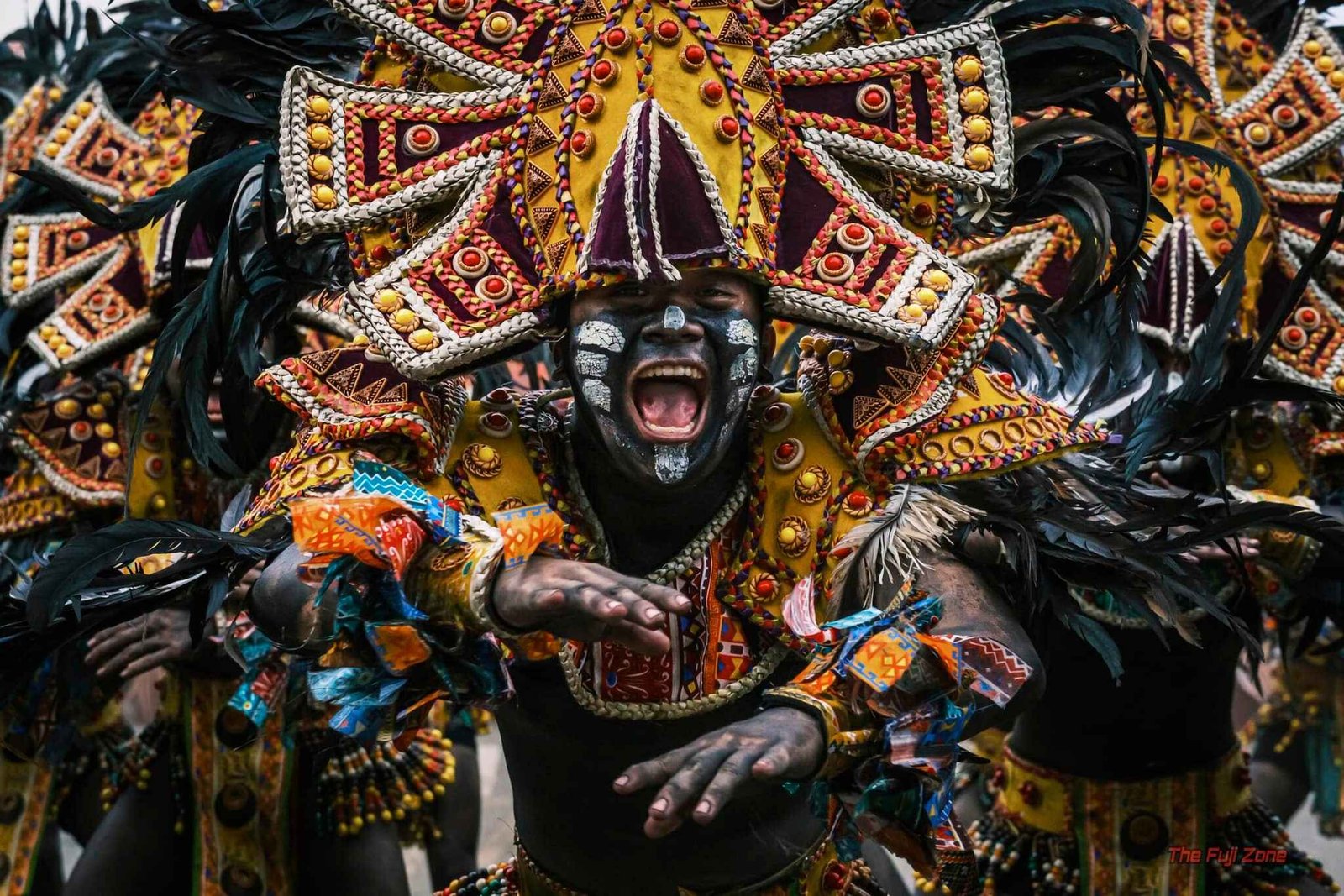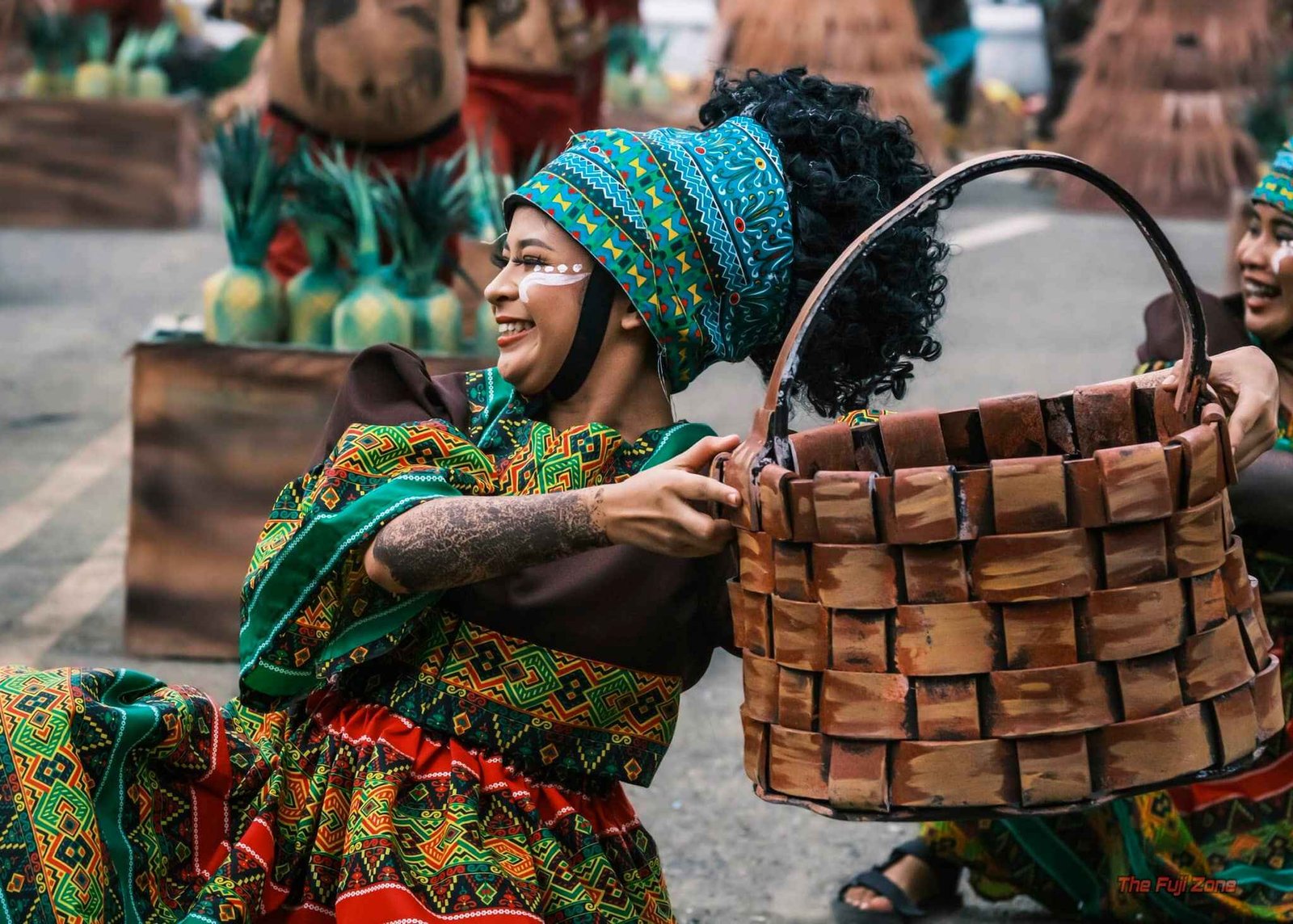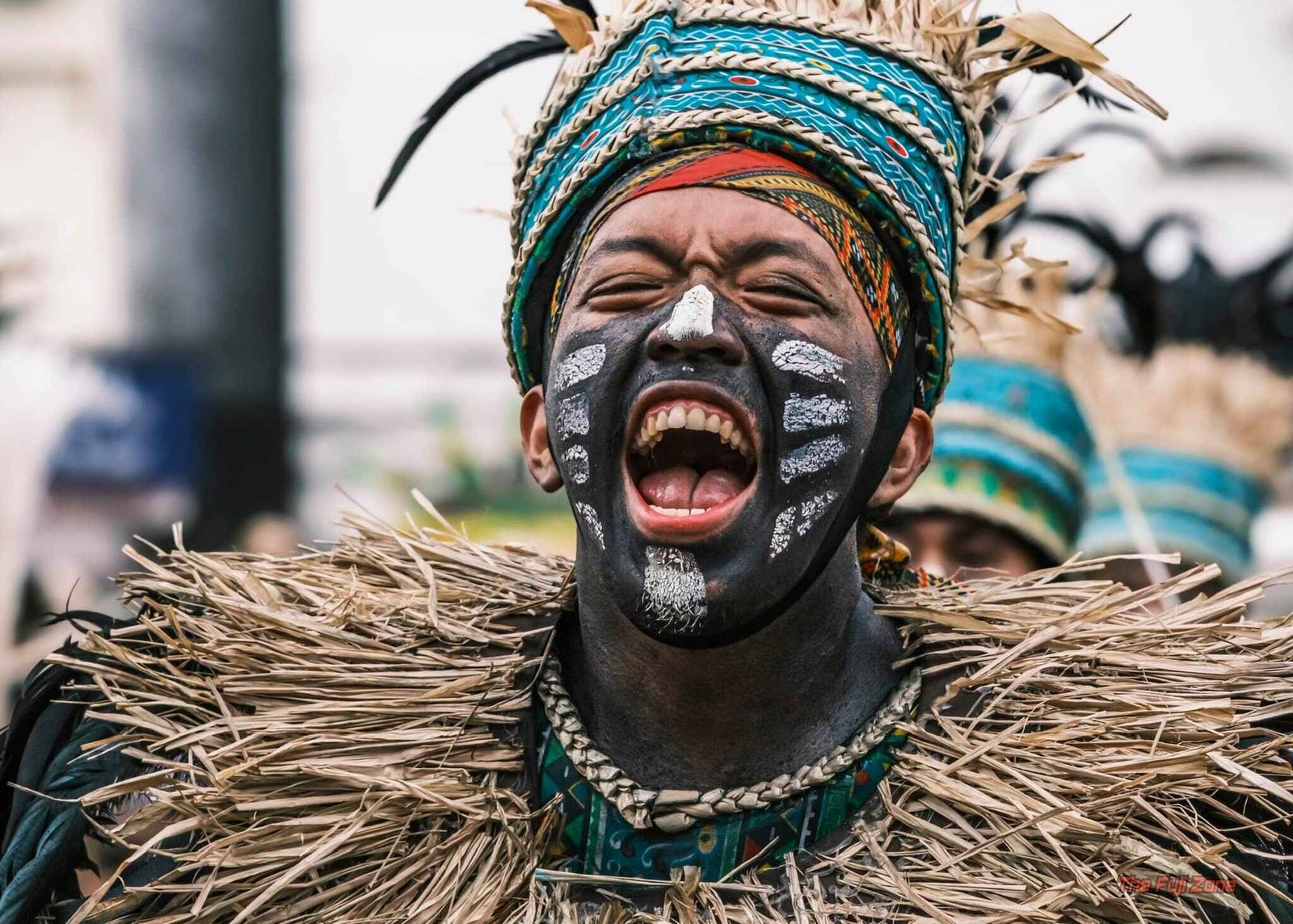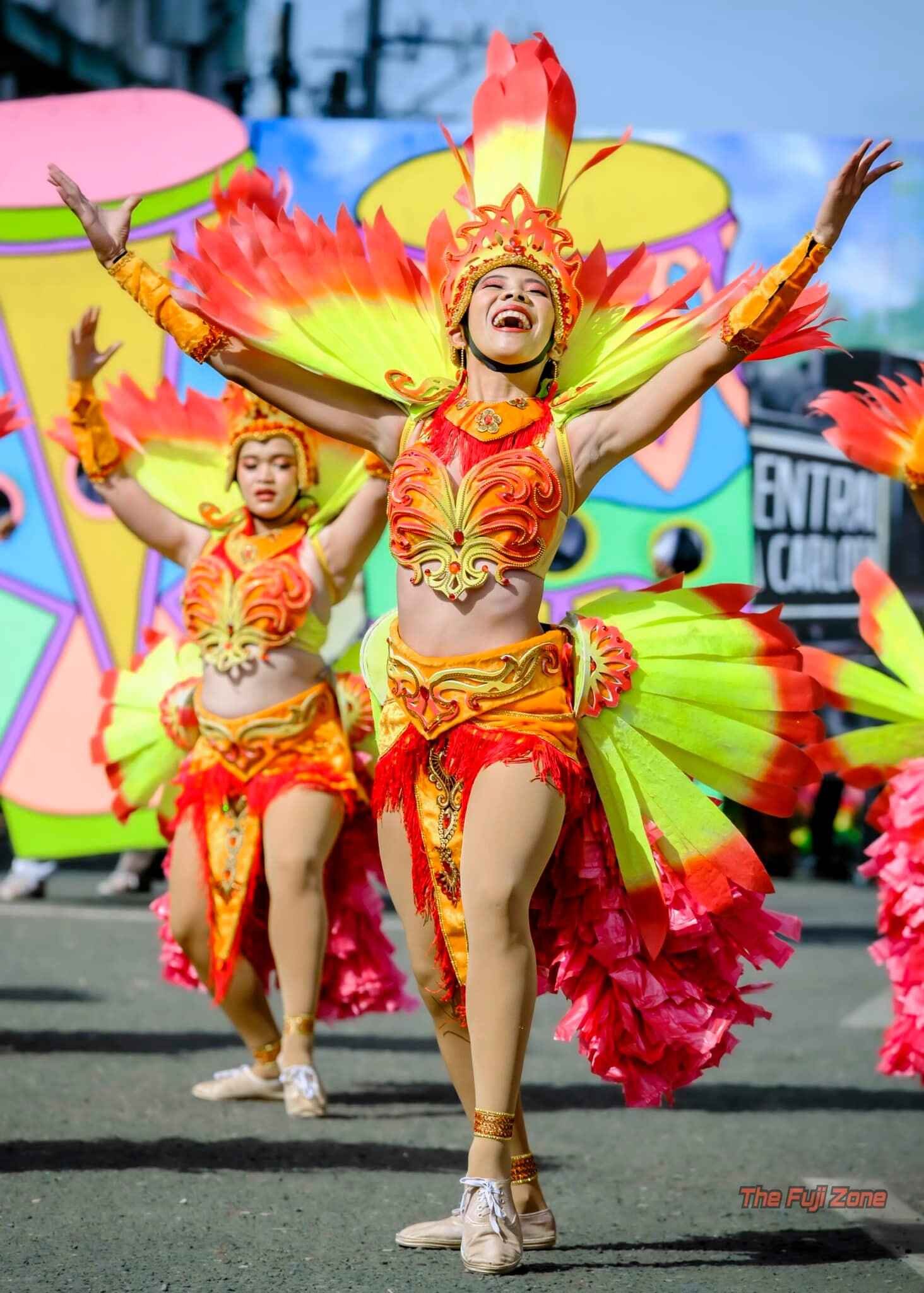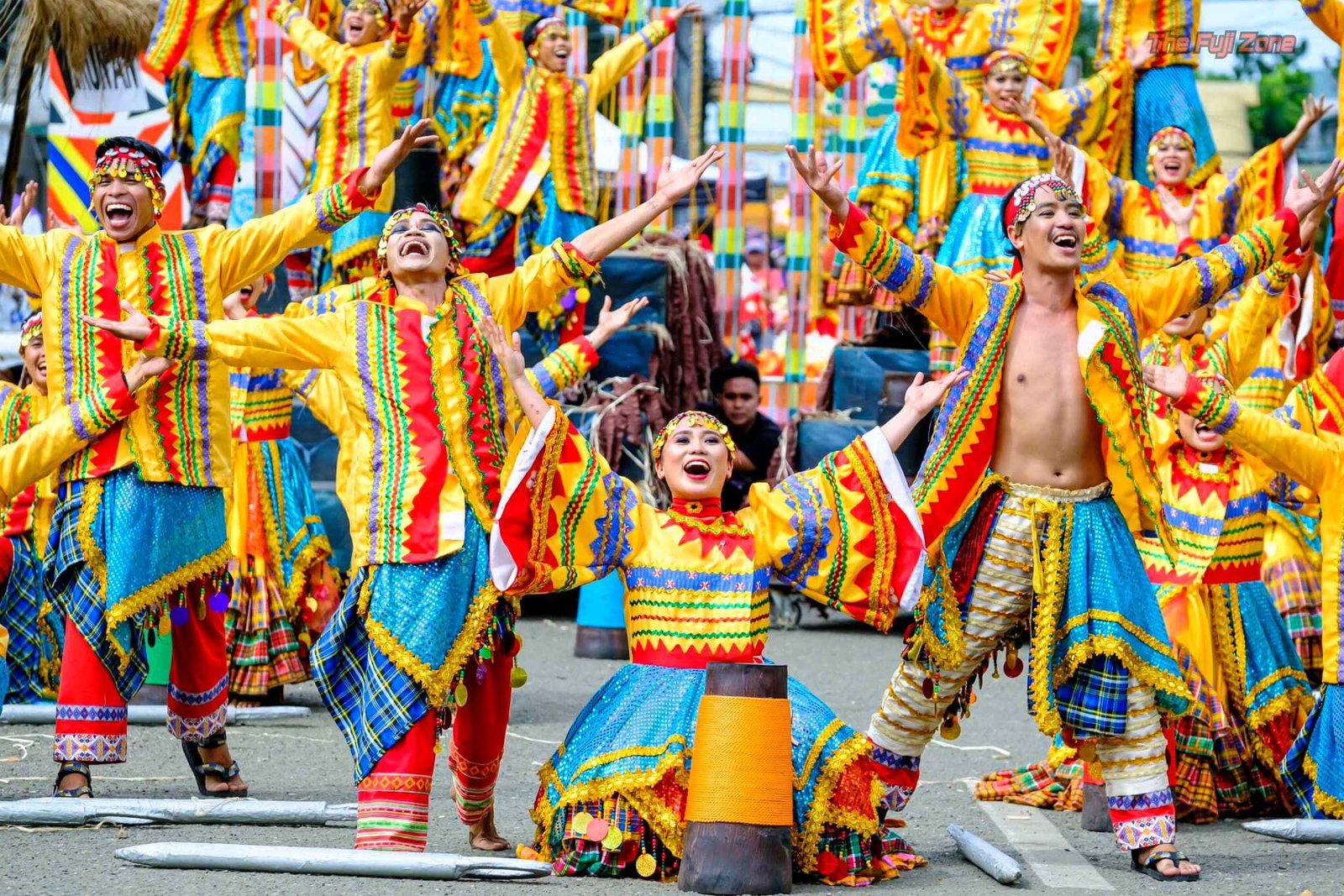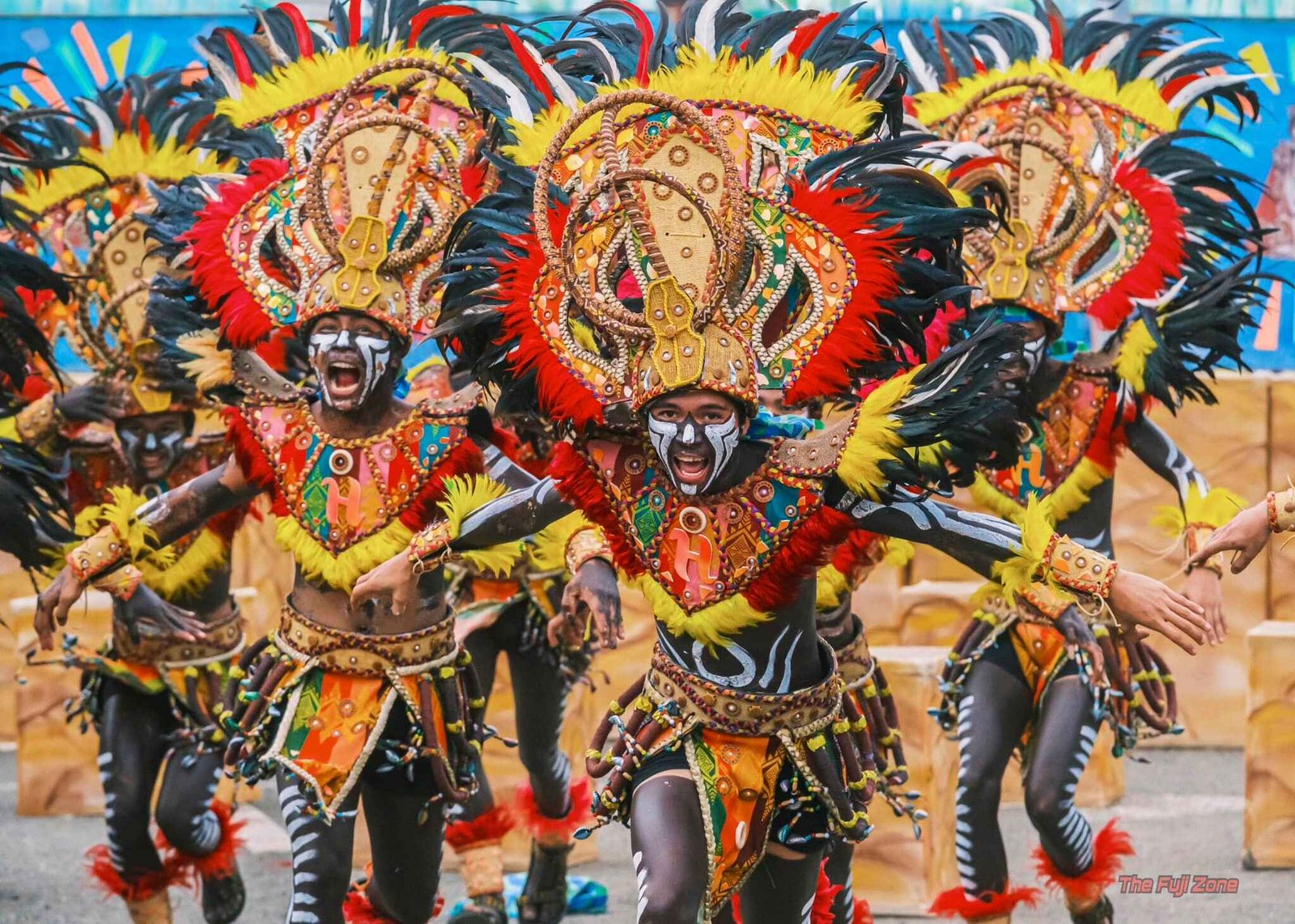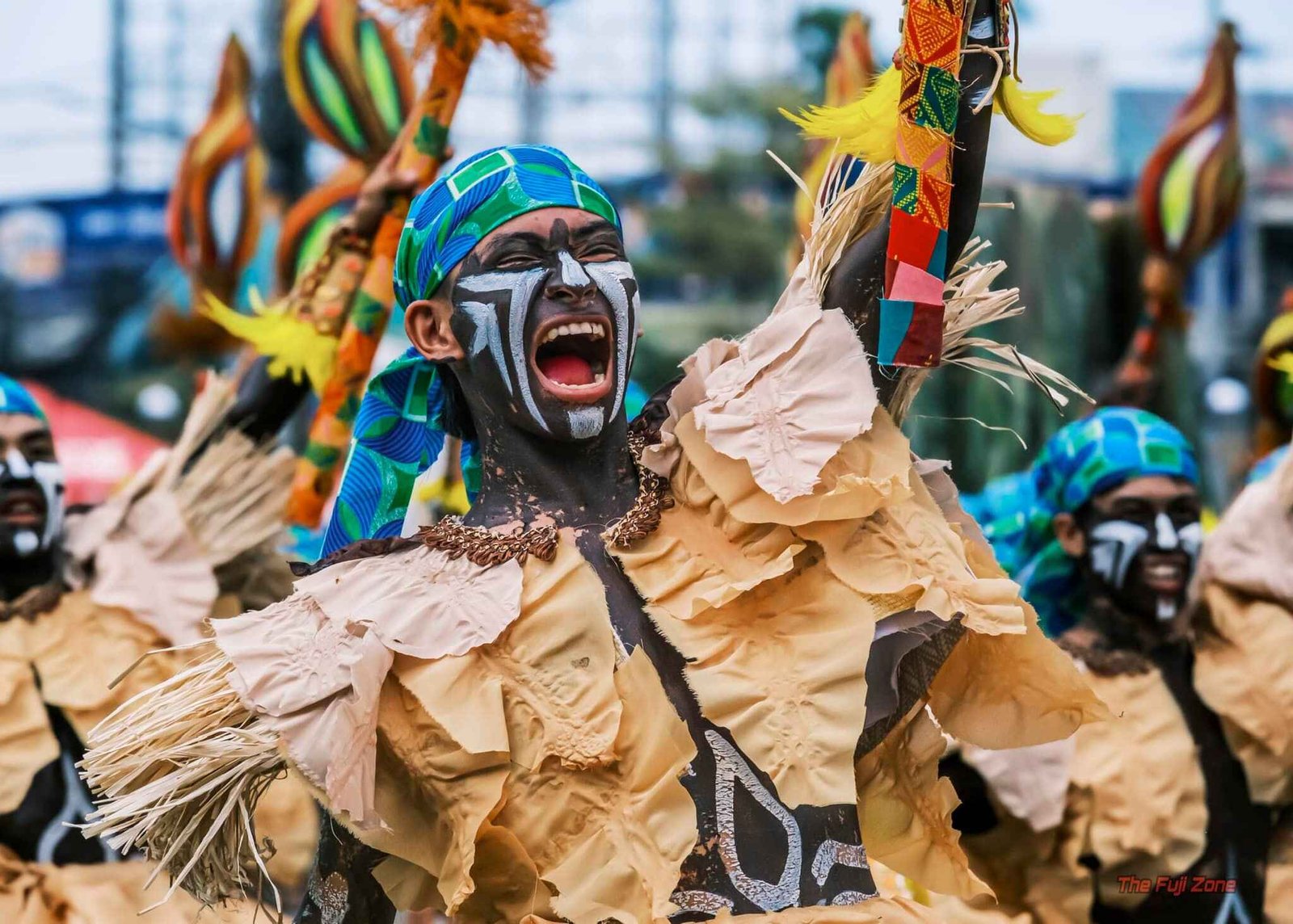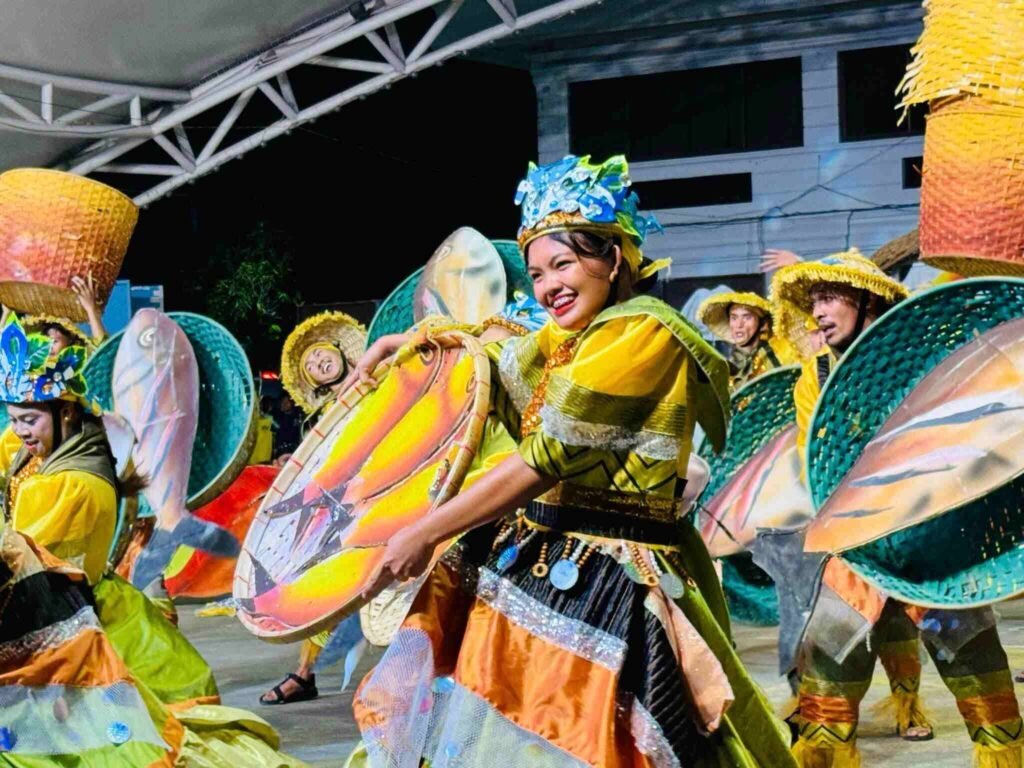Introduction to the Dinagyang Festival
The Dinagyang Festival is one of the most vibrant and culturally significant celebrations in the Philippines. Held annually in Iloilo City, this festival honors the Santo Niño (the Holy Child Jesus) and is a celebration of the indigenous Ati tribes. The term “Dinagyang” comes from the Hiligaynon word meaning “merrymaking,” and the event is a grand fusion of faith, culture, and artistic expression.
Celebrated every fourth Sunday of January, Dinagyang Festival offers a rich spectacle of street dancing, colorful tribal performances, and a deep display of devotion to the Santo Niño. The festival’s meaning is rooted in the Ati tribes’ cultural history, while its religious significance stems from the Christianization of the Philippines. The festival celebrates why Dinagyang is held: to honor both indigenous heritage and religious devotion.
Image Source : Ed DLP (The Fuji Zone)
Table of Contents
Where is the Dinagyang Festival Celebrated?
The Dinagyang Festival is celebrated in Iloilo City, located on the island of Panay in the Western Visayas region of the Philippines. The city comes alive with vibrant parades, dance competitions, and religious processions during the festival. The event has become a crucial part of Iloilo’s identity, showcasing the rich cultural and historical heritage of the region.
As the festival is held in various key locations around the city, including the Freedom Grandstand, it attracts both local and international tourists. The main highlight, the Ati Tribe competition, features performances by tribal groups, often accompanied by loud drumbeats, and colorful costumes, making the streets of Iloilo a spectacle of art, culture, and devotion
The History of the Dinagyang Festival
The Dinagyang Festival traces its roots to 1967 when the image of the Santo Niño was brought from Cebu to the San Jose Parish in Iloilo. Initially, the festival was primarily a religious event celebrating the Santo Niño, modeled after Aklan’s Ati-Atihan Festival. By 1977, it was officially renamed Dinagyang, distinguishing it from similar celebrations. The festival evolved over time to include not only religious rituals but also grand cultural performances.
In terms of its religious roots, the festival was originally organized to celebrate and deepen devotion to the Holy Child Jesus, which answers the question: Is Dinagyang Festival religious? Yes, it is both a religious and cultural celebration, combining Christian traditions with the indigenous Ati culture. The festival has since grown into a large-scale event that embodies the unity of the people of Iloilo, highlighting both their faith and creativity
When and Where is the Dinagyang Festival Celebrated?
The Dinagyang Festival is held annually in Iloilo City, typically on the fourth weekend of January. In 2025, the festival will take place from January 24 to 26, bringing together locals and tourists to celebrate this vibrant event. The festival’s major events, including the Ati Tribes Competition, ILOmination Parade, and Kasadyahan sa Kabanwahanan, will captivate audiences with street performances, illuminated floats, and cultural exhibitions.
The Dinagyang Festival is a month-long celebration that merges Catholic faith and cultural heritage, highlighted by its devotion to the Santo Niño (Holy Child Jesus). The festival has evolved from a small religious event in the 1960s into one of the Philippines’ most renowned cultural spectacles
Cultural and Religious Significance
The Dinagyang Festival holds deep religious significance as it honors the Santo Niño, symbolizing the strong Catholic faith of the Filipino people. At its core, the festival celebrates the arrival of Christianity in the Philippines, alongside the historical Barter of Panay, which commemorates the peaceful exchange between the Ati tribes and Malay settlers. The festival’s religious elements include novena masses, a fluvial procession, and communal prayers, emphasizing the spiritual devotion of the Ilonggo people
Key Highlights and Performances
One of the most anticipated events is the Ati Tribes Competition, where performers dressed as Dinagyang warriors take to the streets in elaborate costumes. These costumes, often adorned with feathers, beads, and native materials like abaca and piña, are not only visually stunning but also reflective of the Ati culture. The intricate designs and cultural significance of these costumes help convey the history and artistry behind the performances.
In addition to the costume spectacle, the ILOmination Parade and Kasadyahan sa Kabanwahanan showcase modern interpretations of traditional celebrations, blending history with innovation. This fusion of the old and new makes Dinagyang a unique and immersive experience for all who attend.
Whether you are attending for the religious aspects, cultural performances, or simply to witness the vibrant Dinagyang Festival costumes, this event promises a rich cultural journey in Iloilo City
Dinagyang Festival Street Dancing Performances and Ati Tribe Competition
The Dinagyang Festival in Iloilo City is one of the most celebrated cultural events in the Philippines, known for its street dancing performances and the grand Ati Tribe Competition. These events encapsulate the festival’s spirit, blending vibrant cultural displays with religious devotion.
Street Dancing Performances
The Dinagyang Festival’s street dancing is an explosion of color and rhythm, with performers taking to the streets in elaborate costumes. These dances are rooted in the tradition of honoring the Ati tribe, an indigenous group in the Philippines. Performers, representing various tribes or contingents, parade through Iloilo’s streets in choreographed routines, accompanied by drumbeats and chants.
What makes these performances particularly captivating is the fusion of cultural and modern elements. The dancers wear bright, intricate tribal costumes that include feathers, beads, and bold face paint, evoking the appearance of Ati warriors. The performances often follow a carousel format, where multiple groups perform simultaneously in various parts of the city, enhancing the experience for both spectators and participants. This unique format, introduced in recent years, allows for dynamic viewing as audiences can witness multiple performances at once.
The street performances also feature Dinagyang Pipes, a distinct musical innovation that adds a unique auditory element to the dances, creating an immersive experience that ties traditional sounds with modern choreography.
Ati Tribe Competition
At the heart of the Dinagyang Festival is the Ati Tribe Competition, which showcases the artistry, talent, and competitive spirit of the participating tribes. This competition is the most anticipated event of the festival and is often considered its pinnacle.
Each participating tribe, usually composed of students from local schools or barangays, performs meticulously rehearsed routines that highlight cultural storytelling through synchronized movements. The dances depict scenes from the history of the Ati people and their role in the arrival of the Santo Niño, a symbol of Catholicism in the Philippines.
The performances are judged on a range of criteria, including:
- Choreography: The precision and creativity of the dance routines.
- Costume Design: Each tribe’s attire is an essential aspect, often showcasing colorful patterns inspired by traditional Ati warrior costumes.
- Musical Accompaniment: The use of drums, gongs, and Dinagyang Pipes to complement the dances.
- Overall Impact: The performance’s ability to captivate and move the audience.
What distinguishes the Ati Tribe Competition is its deep cultural and religious significance. The competition honors both the Ati culture and the Catholic faith by merging indigenous traditions with the veneration of the Santo Niño. This fusion makes the Dinagyang Festival not just a cultural celebration, but also a religious event.
Innovations and Modern Developments
Over the years, the Dinagyang Festival has continued to evolve, integrating modern innovations into the traditional performances. The introduction of mobile risers has enhanced the choreography, enabling tribes to perform more intricate dance patterns with greater visual impact. This innovation, combined with synchronized light displays during the ILOmination Parade of Lights, has transformed the festival into a multi-sensory experience.
Additionally, the inclusion of technology, such as real-time broadcasts of the performances, has expanded the festival’s reach to a global audience. These innovations keep the festival fresh and engaging, while still honoring its cultural roots.
Dinagyang Festival 2025 Itinerary and Schedule
For the Dinagyang 2025 schedule, here’s a suggested itinerary based on the festival’s main events:
Day 1: January 24, 2025
- Arrival in Iloilo City.
- ILOmination Street Dance and Parade of Lights (6 PM onwards): This colorful event features illuminated floats and street dancers in vibrant costumes.
Day 2: January 25, 2025
- Kasadyahan sa Kabanwahanan (8 AM): A cultural parade that showcases the rich heritage of Iloilo’s municipalities through folk dances and performances.
- Religious Fluvial Procession (3 PM): A solemn water parade honoring the Santo Niño.
- Evening free to explore Iloilo’s local markets and food stalls.
Day 3: January 26, 2025
- Ati Tribes Competition (8 AM): The festival’s main event, featuring tribal groups performing synchronized dances in traditional warrior costumes.
- Feast Day High Mass (6 PM): A religious ceremony at the San Jose de Placer Church
This itinerary ensures that you experience the heart of Dinagyang while enjoying the best it has to offer. Make sure to keep an eye on the official schedule as event times may vary closer to the date
Best Places to Stay During the Dinagyang Festival
If you’re attending the Dinagyang Festival 2025, it’s important to book your accommodation early due to high demand during the event. Here are some of the top places to stay, with rates included, to ensure a comfortable and convenient experience in Iloilo City.
1. Richmonde Hotel Iloilo
- Location: Iloilo Business Park
- Rate: Starts at PHP 4,500 to PHP 7,500 per night depending on the room type and amenities.
- Highlights: This luxurious hotel offers a pool, a gym, and an on-site restaurant. It’s perfect for festival-goers who want a balance of comfort and accessibility. The hotel’s proximity to festival events makes it an ideal base. Website
2. Park Inn by Radisson Iloilo
- Location: SM City Iloilo, Mandurriao
- Rate: Starts at PHP 4,000 per night for a standard room and goes up to PHP 8,000 for premium suites.
- Highlights: Directly connected to SM City Iloilo, this hotel provides guests with easy access to shopping and dining options. Amenities include a swimming pool, fitness center, and modern rooms.
3. Zuri Hotel
- Location: Mandurriao, Iloilo City
- Rate: Between PHP 5,000 and PHP 10,000 per night.
- Highlights: Zuri Hotel offers luxurious accommodations, a rooftop infinity pool, and exceptional dining at Z Bistro. It’s a great choice for those wanting high-end experiences close to the Dinagyang venues.
4. Seda Atria
- Location: Smallville Complex, Mandurriao
- Rate: Around PHP 3,500 to PHP 7,000 per night.
- Highlights: This 4-star hotel is ideal for travelers looking for comfort and modern amenities. Seda Atria is near restaurants and bars, perfect for those wanting to enjoy both the festival and nightlife.
5. Airbnb Rentals in Iloilo Business Park
- Location: Iloilo Business Park and nearby areas
- Rate: Varies from PHP 2,500 to PHP 5,000 per night for studio and two-bedroom condos.
- Highlights: Airbnb offers several affordable yet luxurious condo units, many of which feature amenities like pools, kitchen facilities, and easy access to the festival grounds.
Where to Stay During Dinagyang Festival
Mandurriao, Iloilo Business Park, and the City Proper are the best districts to find accommodations for the Dinagyang Festival. These areas provide easy access to festival activities, restaurants, and shops, making it convenient to enjoy the vibrant atmosphere of Iloilo during the event.
Be sure to book as early as possible, as hotels fill up quickly for Dinagyang. Rates tend to increase closer to the event due to high demand, so planning ahead can save money and guarantee better accommodations.
Dinagyang Festival’s Economic and Tourism Impact
The Dinagyang Festival significantly boosts both the tourism and local economy of Iloilo City and the surrounding areas. Every year, the festival attracts thousands of local and international visitors, leading to a surge in demand for accommodations, restaurants, and local services. During the festival, hotels are fully booked, and local eateries experience an influx of diners, which helps small and medium businesses thrive. In fact, local micro-entrepreneurs benefit from the festival through food kiosks, crafts, and art stalls, which generate substantial sales.
Additionally, Dinagyang’s economic influence extends beyond the festival itself. It promotes Ilonggo culture and crafts, particularly in industries like bamboo products from the Tultugan Festival, which raise awareness of the region’s unique industries. The festival also creates employment opportunities in event management, hospitality, and transportation, benefiting various sectors of the city
Conclusion: Why You Should Experience the Dinagyang Festival
The Dinagyang Festival is not just a celebration of faith but also a testament to Iloilo’s rich cultural heritage. With its vibrant street dances, Ati Tribe competitions, and religious devotion to the Santo Niño, the festival offers a unique fusion of tradition and modernity. Visitors will witness the deep spiritual connection of the Ilonggos while enjoying the artistry of the performances.
If you’re planning to visit, make sure to arrive early, as the festival is one of the busiest times of the year in Iloilo. Prepare to immerse yourself in Ilonggo culture, sample local cuisine, and be part of a truly world-class event. Whether it’s your first time or you’re a returning guest, the Dinagyang Festival 2025 promises an unforgettable experience.
Plan your trip now, and don’t miss the chance to witness one of the Philippines’ most spectacular festivals
FAQ’s
1. What is the Dinagyang Festival?
The Dinagyang Festival is a religious and cultural celebration held annually in Iloilo City in honor of the Santo Niño (Holy Child Jesus). It also commemorates the Barter of Panay, marking the peaceful exchange between the Ati tribe and Malay settlers.
2. When is the Dinagyang Festival celebrated?
The Dinagyang Festival is celebrated on the fourth Sunday of January each year. In 2025, the main events will take place from January 24 to 26.
3. Where is the Dinagyang Festival held?
The festival takes place in Iloilo City, Philippines. The main performances and processions occur in the downtown area, with major venues including the Freedom Grandstand and various streets throughout the city.
4. What are the main events of the Dinagyang Festival?
Key events include the Ati Tribe Competition, the ILOmination Parade of Lights, the Kasadyahan sa Kabanwahanan, and religious processions in honor of the Santo Niño. Street dancing and musical performances are also central to the festival.
5. What is the significance of the Dinagyang Festival?
The festival honors the Santo Niño, symbolizing deep-rooted Catholic faith in the Philippines. It also celebrates the cultural heritage of the Ati people and the historical Barter of Panay.
6. What is the Ati Tribe Competition?
The Ati Tribe Competition is the highlight of the Dinagyang Festival. Various “tribes” perform synchronized dances, wearing traditional warrior costumes, and reenacting historical and cultural events.
7. Why is the Dinagyang Festival important for Iloilo’s economy?
The festival draws thousands of tourists, boosting local hotels, restaurants, and small businesses. It also creates job opportunities and promotes the region’s handicrafts and cuisine.
8. How can I attend the Dinagyang Festival?
You can reach Iloilo City by air, sea, or land transport. It’s recommended to book accommodations early, as hotels are often fully booked during the festival.
9. What are some must-try foods during the festival?
Popular Ilonggo dishes to try include La Paz Batchoy, Kansi, and Pancit Molo, all of which are available during the festival’s food stalls.
10. Is the Dinagyang Festival religious?
Yes, the Dinagyang Festival is primarily a religious celebration dedicated to the Santo Niño. It includes religious masses, fluvial processions, and solemn prayers alongside the cultural performances.
These FAQs cover the essentials of the Dinagyang Festival and can help you plan your visit or understand the significance of this important cultural event in Iloilo.

